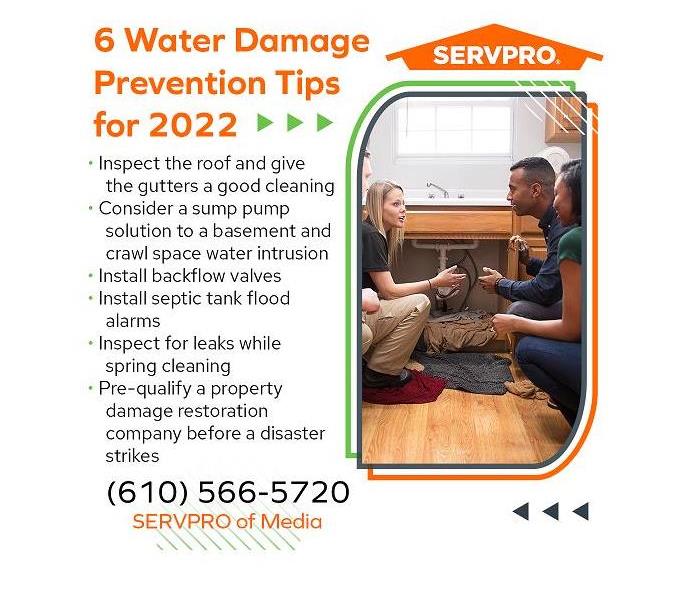Water Damage Prevention Tips for the Spring Cleaning Season
3/14/2022 (Permalink)
Blog Summary: SERVPRO of Media highlights water damage prevention practices that homeowners can incorporate into their 2022 spring cleaning process.
Home maintenance is a never-ending list of chores, many of which must be repeated on a regular basis to ensure the home runs smoothly and without interruption from dust and dirt, as well as water damage or fire damage. Spring is accompanied by an extra load of home maintenance inspections, chores, and repairs. The harsh winter months take their toll on the roof, gutters, landscaping, and hardscapes around the house, and preparations must be made for the summer’s hot temperatures and severe weather. High winds, hail, heavy downpours, and potential flooding are seasonal challenges every homeowner faces. The period from June to November brings the threat of hurricanes, tropical storms, heavy thunderstorms, and tornadoes.
Besides these severe weather conditions, other causes of a water damage disaster include faulty plumbing, a ruptured appliance supply line, a messy sewage backup, or burst pipes from an unexpected late freeze. The opportunities for a surprise water intrusion are numerous.
With a few minor adjustments to the spring-cleaning list, Springfield, PA, homeowners can protect their homes from an unwanted water damage disaster. Any property damage disaster is disruptive and stressful. Below is a list of tips with some proactive steps to help prevent a water intrusion from happening at all.
Six Water Damage Prevention Tips for 2022
#1: Inspect the roof and give the gutters a good cleaning
Leaves and sticks can clog gutters during the winter. Spring and summer cloudbursts can dump inches of rain per hour onto the roof. If the water flow in the gutters is impeded in any way, an overflow is sure to occur. Clean and flush gutters so they are free-flowing. Inspect downspouts to ensure they are connected and are removing water away from the foundation of the home.
#2: Consider a sump pump solution to a basement and crawl space water intrusion
A sump pump system is a reliable solution to evacuate excess water from the basement or crawl space before it becomes a problem. A backup pump and an alternative power source are crucial to ensure the system functions properly during a power outage. The exhaust pipe should be located away from the foundation to prevent evacuated water from seeping back into the structure. The configuration and installation of the system are best left to licensed, bonded, and insured professionals who know sump pumps.
#3: Install backflow valves
Heavy water flow can overwhelm the capacity of a home’s plumbing system. When drains overflow and sewage systems back up, the sewage must go somewhere. The path of least resistance sends sewage into sinks, tubs, and showers. Appliances such as the washing machine and dishwasher are not immune to the sewage backup into the home. Since it contains raw sewage, the water is toxic and a danger to the health and well-being of both humans and pets. A certified, licensed, and bonded plumber can install valves and plugs that effectively prevent a hazardous backflow in the event of flooding.
The pathogens in contaminated water make for a hazardous cleanup scene requiring PPE (Personal Protective Equipment), special cleaning products, and certified technicians who know what they are doing. The odor must be eliminated, and the damage zone must be sanitized to make it a livable and safe environment for humans and pets.
#4: Install septic tank flood alarms
Septic tank flood alarms alert the homeowner that the septic tank may be close to full. During periods of heavy rainfall, such as in the aftermath of a hurricane or a stalled tropical storm, the sewage leach field may become saturated and unable to absorb water from the septic tank. The full tank will back up into the home if the household’s water usage is not immediately curtailed. Even if the septic tank was recently pumped, the excess wet weather may necessitate an immediate re-pumping to prevent a sewage backup. Once the weather clears and the ground dries up, the leach field will be able to disperse the liquids and absorb more of the fluids in the septic tank.
#5: Inspect for leaks while spring cleaning
When spring cleaning, look, listen, and smell for leaks around faucets, under cabinets, around toilets, and under appliances. Secure the services of a certified, licensed plumber to remedy these issues. A DIY disaster could be much more costly than the expense of hiring a plumber.
#6: Pre-qualify a property damage restoration company before a disaster strikes
If a large-scale spring storm strikes the Media, PA, area, the homeowner may find it all but impossible to reach a damage cleanup and restoration company. Thousands of homeowners and businesses may all be calling at the same time. With a pre-qualified service provider, one call achieves results. If the damage restoration company selected is SERVPRO of Media, a crew arrives on the scene within an hour.
To learn more details about Media, PA, water damage cleanup, call SERVPRO of Media at (610) 566-5720 or email office@SERVPROmedia.com






 24/7 Emergency Service
24/7 Emergency Service
